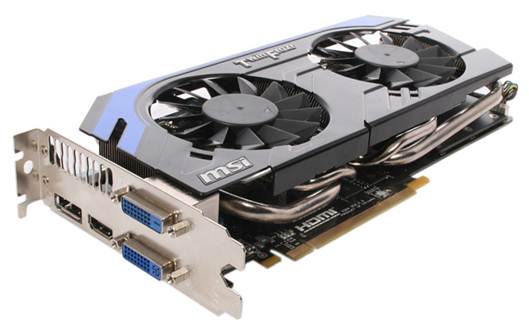nVidia takes on AMD in the
hard-fought mid-range graphics market, but how does Kepler fair against its
established rivals?
Most of the attention, when it comes to
graphics cards, is paid to the high-end monsters: the $800 GPUs that break
benchmark records and make bank accounts cower. That's all well and good, but
NVidia and AMD know that the mid-range is where there's real money to be made -
after all, Steam's latest hardware survey shows that NVidia's GTX 460 and 560
Ti and AMD's Radeon HD 5770 are among the most popular graphics cards in use
today.
It's a hard-fought area and, for the past
several months, AMD has had it all its own way: its Radeon HD 7800 and
7900-series cards have ruled the roost, with NVidia's $485+ GeForce GTX 670
just too expensive to challenge in this area.

NVidia
GeForce GTX 660 Ti
That's about to change with the arrival of
the GeForce GTX 660 Ti. It's still produced from the Kepler architecture used
for the rest of NVidia's current top-end cards, and the firm hasn't done much
to make the new chip, essentially taking the GTX 670, scaling it back a little,
and slapping a new name on the PCB.
That means the card still uses seven of the
eight graphics processing clusters (GPCs), that were included in the
top-of-the-range GTX 680. The deactivation of one GPC means the stream
processor count steps down 1,536 to 1,344, and there's one other change to be
found inside each cluster: each one still has 112 texture units, but the GTX
660 Ti has just 24 render output units. That's 12 less than each GPC inside the
GeForce GTX 670 had, and it could prove harmful to the new card's ability to
handle complex techniques like anti-aliasing.
The base clock still sits at 915MHz and,
like the GTX 670, the GTX 660 Ti features a maximum boost clock of 980MHz - so
the core will automatically overclock itself if more power is required. The 2GB
of GDDR5 RAM still runs at a speedy 6,008MHz, although it's here where NVidia
has made another minor change to the specification: instead of still being
channeled through a 256-bit bus, the GTX 660 Ti makes do with a 192-bit bus
instead.
AMD, meanwhile, isn't taking the NVidia
challenge lying down. Its main competition in terms of price is the Radeon HD
7950, which can be bought for between $403.22 and $483.87, but the red team has
sensed that NVidia will trump its card in benchmarks.
That's why AMD has just released a BIOS
update for its new card. This alters the HD 7950's clock speed dramatically:
the base level has been boosted from 800MHz to 850MHz, and the new Boost
feature can dynamically overclock the core to a peak of 925MHz when
applications demand extra oomph. We've retested the HD 7950 using this new BIOS
update to see which mid-range card comes out on top.
There's little between the two cards in the
majority of our benchmarks. First up to the plate was Crysis, and it was
the NVidia card that struck the first blow: in the 1920 x 1080 Very High
quality test the GTX 660 Ti scored 66fps, with the Radeon two frames behind.
The gap widened at 2560 x 1440, with the NVidia's score of 48fps six frames
ahead of its rival, but the HD 7950 clawed back some ground when we hooked up
three screens. At the mighty resolution of 5760 x 1080, the HD 7950's 35fps
trounced the GTX 660 Ti's 26fps.
In Crysis 2 the NVidia card
again started well. At 1920 x 1080 and with the game's Extreme settings
activated, the GeForce's 54fps result was one frame more than the AMD chip
could manage, and both chips scored 30fps when we upped the resolution to 2560 x
1440. It was the Radeon that proved its worth across three screens again, but
the gap was narrowed this time: the HD 7950 scored 30fps when running High
quality settings at 560 x 1080 - only two frames ahead of NVidia.
Competition was fierce in Just Cause
2 and DiRT 3, too: the GTX 660 Ti scored 114fps to the AMD
card's 101fps in Just Cause 2 at 1920 x 1080, both scored
73fps across the larger monitor, and the HD 7950's 48fps result at 5760 x 1080
was only one frame faster than the NVidia chip managed. The GTX 660 Ti was more
convincing in DiRT 3: at 1920 x 1080 and 2560 x 1440 the NVidia
chip was at least 12 frames quicker and, for the only time in this test, the
NVidia card triumphed across the screens.

Gigabyte
GeForce GTX 660 Ti
The GTX 660 Ti took a comprehensive victory
in our thermal and sound tests. The GTX 660 Ti drew just 5W more at peak from
the mains in our test rig, with a peak power draw of 251W perfectly reasonable,
and its top temperature of 74°C is nothing to worry about. Our review sample, from
Asus, was also extremely quiet even during demanding games - something we
couldn't say about our noisy AMD card.
Before AMD's sneaky BIOS update there'd be
no arguments as to which card to buy, but the Radeon HD 7950's boosted clock
speed has given NVidia food for thought. Still, though, benchmarks don't lie:
while the HD 7950 beats the NVidia card in several tests and isn't far behind
in many more, the bottom line is that the GeForce GTX 660 Ti is quicker in the
majority of tests across most of our games.
It's good value for money, too: while the
HD 7950 costs between $400and $485, NVidia's latest card can be had from
between $403.22 and $451.61. If you're after top-notch mid-range performance,
then, the tables have turned: buy the NVidia GeForce GTX 660 Ti.